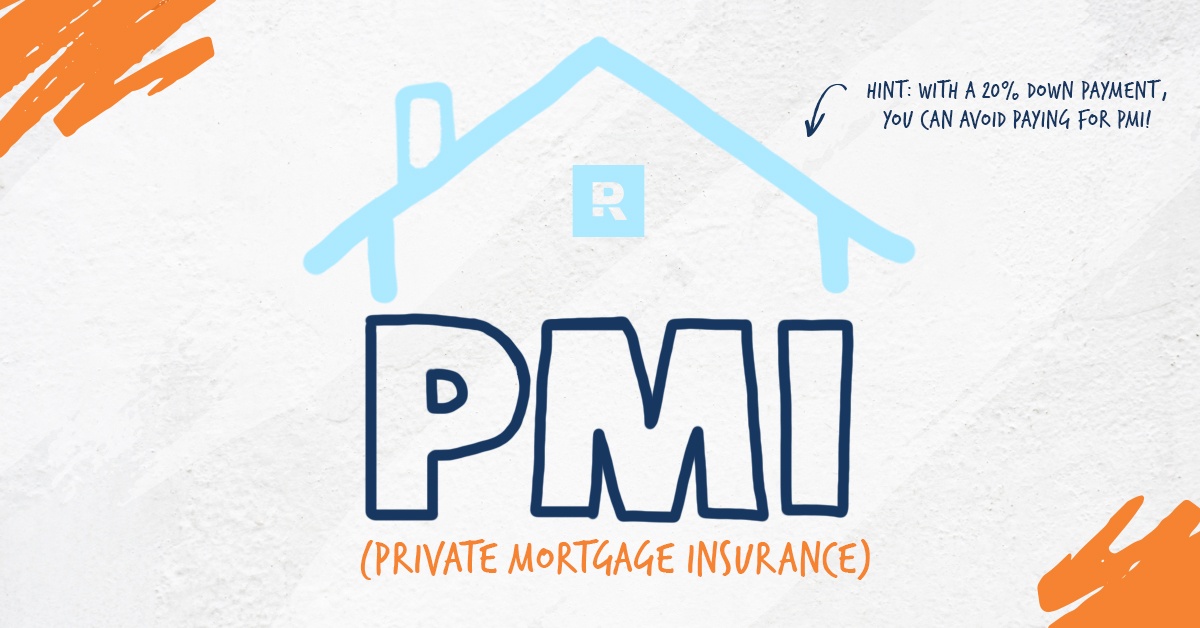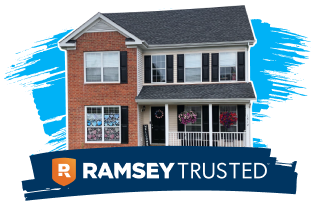What Is Private Mortgage Insurance (PMI) and How Does It Work?
9 Min Read | Mar 27, 2025

Key Takeaways
- Private mortgage insurance (PMI) is a fee added to your mortgage when your down payment is less than 20% of the home’s purchase price.
- PMI protects the lender—not the homeowner—in case the borrower defaults on the loan.
- PMI can cost anywhere from 0.58–1.86% of your total annual loan balance.
- You can request cancellation for your PMI once you reach 20% equity in your home.
Once you make an offer on a home and move through the final steps of the mortgage approval process, you will probably encounter a new term: private mortgage insurance, or PMI. Let’s take a look at what PMI is, how it works, how much it’ll cost you, and how you can avoid that sucker!
What Is PMI?
Private mortgage insurance (PMI) is a fee added to your mortgage if your down payment is less than 20% when buying a house or you’re borrowing more than 80% of the home price from a mortgage lender. The PMI fee goes toward insurance coverage that protects your lender—not you—in case you can’t make monthly payments and default on your loan. Your lender then can foreclose your house and auction it off to earn back the money they loaned you.
At a foreclosure auction, lenders can recover about 80% of a home’s value. But obviously no one likes losing money, so to make up the other 20%, lenders require buyers to pay for an insurance policy—the PMI—to protect themselves from potential loss.
Fun fact: Some people call it PMI insurance, but we prefer to lose the extra insurance and just call it PMI.
How Does PMI Work?
PMI is a lot like any insurance policy where you make payments every month for coverage. But remember, it only protects lenders—not homeowners. Here’s how it works:
- Once PMI is required, your mortgage lender will arrange it through their own insurance providers. This will probably happen after your offer on a house is accepted and while your mortgage is being processed.
- You will see your PMI premium brightly shining on your Loan Estimate document.
- You’ll also be told early on in the mortgage process how many PMI payments you’ll have to make and for how long, and you’ll pay them every month on top of your mortgage principal, interest and any other fees, and should see this on your Loan Estimate as well.
- Your PMI payment will then roll up into your monthly mortgage after you close on your home, so you’ll pay for both of those at the same time each month.
- Sometimes, you will have the option to pay a one-time, up-front PMI premium at your home closing, so make sure you’re clear what you’re expected to pay and when.
- You can request to have your PMI cancelled when your mortgage balance is 80% of your home’s original value. And when you hit 78% of your home’s original appraised value, your PMI will automatically be cancelled.1 After this, your monthly mortgage payment will go down—yay!
- Don’t forget: You can avoid paying PMI completely by putting 20% or more down on your home!
PMI in no way covers your ability to pay your mortgage. PMI covers your lender because they’re the ones lending you more than 80% of the sale price.
Get the right mortgage from a trusted lender.
Whether you’re buying or refinancing, you can trust Churchill Mortgage to help you choose the best mortgage with a locked-in rate.
How Much Does PMI Cost?
PMI can cost anywhere from 0.58–1.86% of your total annual loan balance.2 In other words, the more money you borrow beyond 80% of your home price, the higher your cost for PMI.
Dave Ramsey recommends one mortgage company. This one!
You could pay the annual PMI fee up front along with all your closing costs or split it into monthly payments as part of your mortgage. What most buyers don’t realize is that PMI can add hundreds of dollars a month to their mortgage payments. And that really adds up!
So to avoid being house poor, we teach people to never buy a house with a monthly payment that’s more than 25% of their take-home pay. That 25% limit includes principal, interest, property taxes, homeowners insurance and especially PMI!
Side note: Don’t forget to also consider homeowners association (HOA) fees when preparing your monthly home budget—in case your new house is part of an HOA.
How to Calculate PMI
You can find out how PMI will impact your mortgage with our mortgage calculator. For example, let’s pretend you’ve bought a house for $250,000 with a 10% down payment. If your lender charged you a PMI rate of 1%, here’s how all the numbers would break down:
|
Home price: |
$250,000 |
|
Down payment: |
$25,000 (10% of home price) |
|
Loan amount: |
$225,000 |
|
Rate of PMI: |
1% |
|
Annual PMI payment: |
$2,250 (1% of loan amount) |
|
Monthly PMI payment: |
$187.50 |
To sum this example up, basically you’re seeing that PMI adds close to $200 extra onto your mortgage every month to insure the lender—not you!
Do All Lenders Require PMI?
Sorry to break it to you: Most lenders require PMI if your down payment is less than 20% on a conventional mortgage. Still, you can find lenders out there who offer unconventional mortgages that allow you to skip PMI even if your down payment is super low. But stay alert! They’ll make up for that PMI somehow—usually by charging you an extra fee or a higher interest rate.
For example, unconventional loans like FHA and VA don’t exactly require PMI. But notice how they charge you a similar, alternative fee:
- FHA loan (Federal Housing Administration). Instead of PMI, FHA loans come with a mortgage insurance premium (MIP). The annual rate (0.85%) is nearly the same percentage as PMI—but it also comes with an up-front MIP fee paid at closing that costs 1.75% of your loan amount.3 And unlike PMI, there’s no way to cancel MIP, so you have to keep paying it for the life of your line or for 11 years if you put 10% down. No thanks.
- VA loan (U.S. Department of Veterans Affairs). If you’re a veteran, VA loans are another way to avoid PMI. But—surprise!—VA loans come with a funding fee that’s 1.4–3.6% of your total loan amount.4 You might find a way around the fee, but buying a house with little to no down payment is a bad idea. You’ll pay so much extra in interest! And you could risk owing more than your home is worth if something changes in the housing market.
Any way you slice it, lenders are going to require some form of PMI (or a similar fee) if your down payment amount is less than 20%—otherwise, there’d be no way for them to make up their loss if you can’t make your mortgage payments and end up in foreclosure.
Is Having PMI Bad?
PMI isn’t a bad thing in the sense that it’s not putting you or your house at risk. But it’s definitely not a good thing either. PMI means thousands of dollars coming out of your pocket with no benefit to you at all. It’s best to dodge PMI whenever possible.
The only way to avoid private mortgage insurance is to save up a down payment that’s 20% or more of your home price. We get it—saving up that kind of money takes serious determination. After all, 20% of a $250,000 house is $50,000. You need patience and intensity to save for even half that—but you can do it!
In fact, if you followed what we teach at Ramsey, you’d be debt-free and have an emergency fund of three to six months of living expenses before shopping for a house. Imagine how much momentum that’d give you to save for a 20% down payment! For more ideas on how to save a big down payment fast, check out our free Saving for a Down Payment Guide.
Another way to help you hit that 20% down payment and avoid PMI is to shop for a less expensive house. That way, you can make your down payment savings go a lot farther! An agent who eats, sleeps and breathes real estate knows where to find the best homes with the lowest prices as soon as they hit the market. For a quick and easy way to find an experienced real estate agent near you, try our RamseyTrusted program.
Now, if reaching that 20% down payment is simply out of reach for you—unfortunately, you will have to pay for PMI. But don’t worry, there are ways you can eventually have it removed from your mortgage.
Want More Expert Real Estate Advice?
Sign up for our newsletter! It’s packed with practical tips to help you tackle the housing market and buy or sell your home with confidence—delivered straight to your inbox twice a month!
How to Get Rid of PMI
Okay, here are a couple of things you can do to say goodbye to PMI:
1. Pay Extra on Your Mortgage Every Month
You could overpay on your mortgage every month and reach the point that you owe 80% or less, faster. That could get pretty tricky, though, because you’d have to find the extra cash every month.
But let’s take our example above and pretend you are able to pay off an extra $25,000 in a few years. Why not wait to buy the house and save up for a year or so? You could then buy that $250,000 dream home, put down 20%, and avoid PMI completely. Now that’s something to consider!
2. Get a New Home Appraisal
Keep track of your home’s value! If it ends up being worth more than it was the year before (because more people are moving to the area, for example), this means more equity in your name. Equity is the dollar value of your home that belongs to you (how much you’ve paid off plus any value growth)—basically, it’s the market value of your home minus your loan balance.
Ask for a new appraisal from your lender if you think your home value has risen enough to boost your equity to more than 20%. As long as you owe less than 80% of the new appraisal, you might be able to write to your mortgage lender and request to end PMI. But it’s up to you to pay for the new appraisal and follow the proper steps when asking your lender to end PMI early.
Having your home appraised after a few years, along with paying a little extra in mortgage payments every month, could get you to that magical 80/20 threshold much faster—and that equals big savings!
Get a Low-Cost Mortgage You Can Actually Pay Off
We know the mortgage process can be a minefield, but you don’t have to go through it alone. Working with a trusted mortgage provider will give you peace of mind, knowing you’re making the best decision with the best information available.
That’s why we recommend our friends at Churchill Mortgage. The loan specialists at Churchill Mortgage are RamseyTrusted—meaning they actually care about helping home buyers find the cheapest overall mortgage to pay off their homes fast. They’ll show you the true cost and savings of each loan option and coach you to make the best decision based on your budget and goals.
Did you find this article helpful? Share it!

We Hear You!
We’re considering adding the ability to save articles to your Ramsey account.




